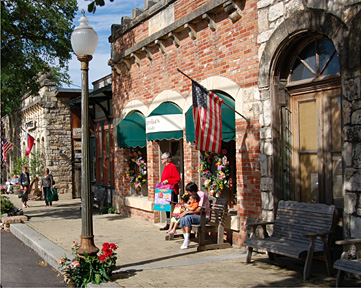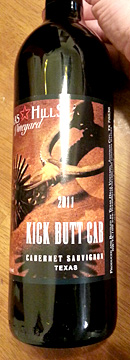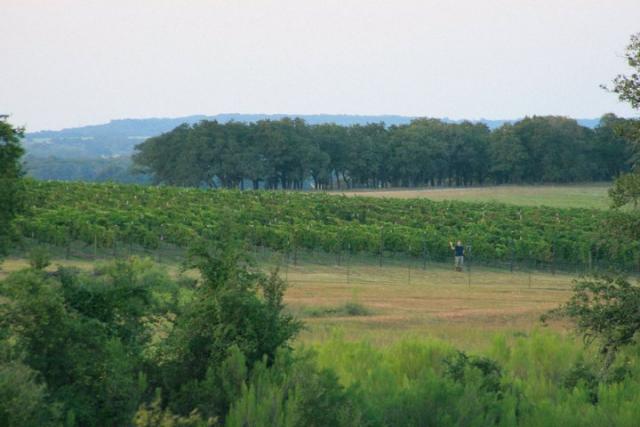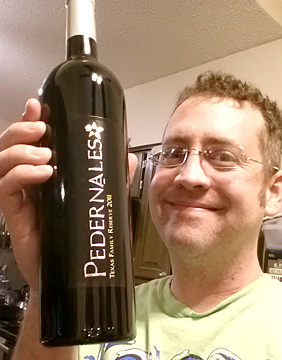In a recent conversation with a potential FRANK diner, the subject of Texas wines arose.
“There are some amazing Texas wines!” I happily responded.
“No,” countered Jennie, “There’s no good wine in Texas.”
This sparked a bit of a debate. “Have you ever tasted a good Texas wine?” Jennie asked.
“Well…..I have tasted an amazing Texas port. But if you’re asking me about amazing whites or reds, to be honest, I haven’t. But I know many sommeliers who say there are some extraordinary wines made here.”
“But have you tasted one?” she pressed.
“Well…no.”
“I see,” she said cattily. And that was that.
Texas wines have been plagued by a bad reputation arising from attempts in the 80s and 90s by Texas winemakers to grow “popular” grapes like Cabernet Sauvignon, Merlot, and Chardonnay, and since none of these varietals do well in Texas soils, the resulting wines tasted…well…more like diesel than wine.
But you can’t blame them. Texas has never been known as a hugely-informed wine market. While there are MANY urban Texans who know and drink good wine, all it takes is a trip into a liquor store or grocery store in most smaller cities in the state to make it painfully clear that wine isn’t as popular as beer here. You’re lucky to find much beyond the basic cabs and chardonnays from the mega producers in California for $6 a bottle. Even in my suburb of Dallas, I have to drive 10 minutes to a big liquor and wine store to get anything special…the grocery stores and beer/wine stores in the area only stock basic, inexpensive, mass-produced wines, so I have to go out of my way to get even a decent bottle. So the vintners here thought they needed to stick to easily recognizable varietals like Chardonnay in order to be able to sell their wines…and even worse, because so many entry-level wine drinkers in Texas prefer cheap, sweet wines, many Texas wines were backsweetened after the fermentation process, resulting in sugary white and red “table wines” that were so sweet, no trace of the original grape’s character was to be found in the glass.

It wasn’t always like this. In fact, Texas grapes saved the French wine industry from oblivion…a fact known by few Texans but by literally every Frenchman. In the late 1800s, a disease called phylloxera ravaged grapevines across much of Europe, destroying virtually every living vine there. A horticulturist named Thomas Munson who lived in Denison, TX provided the French government with root stocks from our wild grapes (we have 15 native grape varieties growing here, more than any other region on earth according to the World Atlas of Wine), which he had cross-bred to build a resistance to phylloxera. French grape growers immediately grafted the few remaining vines they had living onto our Texas root stocks. Now, virtually every vine in Europe is growing on Texas grape root stock, producing the best, most expensive, and most sought after wines in the world. And Munson’s 1909 tome, Foundations of American Grape Culture, is STILL in print and STILL referenced by vineyards across the world. California’s legendary wine industry has everything to thank for this document.
Though his work was predominantly in the late 1800s, wine was already being produced in Texas for centuries before. Mission grapes were planted in the 1650s by monks near El Paso for making sacramental wine, more than a century before the first vines were planted in California. And our many species of wild grapes have been used to make homemade wine in farmhouses here since the 1800s. But everything derailed when commercial vineyards decided to plant popular, recognizable wine varietals so their wines would sound familiar on the shelves, rather than actually looking at our soil and climate, and planting grapes that would actually produce great wine in this “terroir” (the French term for the characteristics of a place, and its appropriateness for specific types of plants).
Consequently, we developed this reputation for making terrible wine, and I’ll be honest, I’ve never tasted a bottle of Texas Cabernet or Chardonnay that was even drinkable. (And I’m no wine snob, I’ll happily sip a glass of Yellowtail, Barefoot, or Charles Shaw…ie, “two buck Chuck.”) Yet Cabernet Sauvignon and Chardonnay still represent the vast majority of wine grapes grown in Texas, despite the fact that our terroir is more appropriate for less familiar varietals like Tempranillo (tem-pran-EE-yo) and Viognier (vee-yon-yay). Meaning, the majority of Texas wines continue to be sub-par.
But surely not all! And I was determined to show Jennie that there are good…even superior Texas wines. It would be a hard sell. Jennie is hugely informed about wine. And while she’s also no snob and has a variety of favorites less than $10 a bottle, all the Texas wines she had ever tasted were so bad she would happily pay NOT to drink them.

On a recent trip to the Texas hill country, we found ourselves in Salado, a charming historic village 50 miles north of Austin, famous for its antique galleries, but is now populated with a disproportionate number of wineries for its size. We chose the one with the best reviews on Yelp, and I’ll decline to mention which one simply because I don’t want anyone to get in trouble for the following story.
We walked into the empty tasting/retail room and were greeted by a young woman who offered us a tasting of 6 wines they make right there in-house. We choked our way through the first few vintages, with bouquets of sulfur and notes of diesel and sewage on the tongue…and it looked like all I was doing was further cementing Jennie’s skepticism about Texas’s potential as a wine powerhouse.
“Do you know if Texas wines are getting a better reputation lately?” she asked the girl.
“Oh, yeah,” the girl replied. “Last time I read about the most popular wines in the US, the most popular come from America, next was Virginia, and then Texas. So our wine is really popular.”
 We weren’t entirely sure what to make of her comment, and it’s entirely possible it was, in fact, an educated comment, despite how it sounded. Texas vintners often bring in grapes from other states, and when the percentage of grapes from out-of-state exceeds 25%, the wine must be labeled “American wine” rather than “Texas wine.” I haven’t heard of any Texas vintners bringing in grapes from Virginia, though, so it’s entirely possible this girl thinks “America” is a state somewhere in the US, and also thinks that Virginia wines are lauded above California, Oregon, Washington, and upstate New York, which currently produce the finest wines in the US. But nothing she had on offer was endurable. Feeling bad, I bought 2 bottles of Texas wine that were not made on-site…a Cabernet affectionately called “Kick Butt,” the favorite of the girl behind the counter, and a dry rosé. Jennie adores rosé, and I figured it would be really hard to mess up a rosé.
We weren’t entirely sure what to make of her comment, and it’s entirely possible it was, in fact, an educated comment, despite how it sounded. Texas vintners often bring in grapes from other states, and when the percentage of grapes from out-of-state exceeds 25%, the wine must be labeled “American wine” rather than “Texas wine.” I haven’t heard of any Texas vintners bringing in grapes from Virginia, though, so it’s entirely possible this girl thinks “America” is a state somewhere in the US, and also thinks that Virginia wines are lauded above California, Oregon, Washington, and upstate New York, which currently produce the finest wines in the US. But nothing she had on offer was endurable. Feeling bad, I bought 2 bottles of Texas wine that were not made on-site…a Cabernet affectionately called “Kick Butt,” the favorite of the girl behind the counter, and a dry rosé. Jennie adores rosé, and I figured it would be really hard to mess up a rosé.
Later that night, we popped the rosé after a brief chill. (Rosés can be served anywhere from room temp to very cold depending on the character of the wine, but it’s perfectly fine to drink most rosés at room temp, and in fact you’ll experience much more flavor from a room temp rosé than a chilled one. Cold temperatures reduce the number of flavors that the tongue can perceive, and if you don’t believe me, take a scoop of ice cream and let it thaw to room temp. Then taste a spoon of the frozen ice cream, and then the melted. They will taste completely different. I actually drink IPA beer at room temperature, because it’s much more complex and delicious than chilled.) I found the rosé to be perfectly serviceable, and, in fact, drank the whole bottle myself. It was too sweet for Jennie, though it would still be ultimately characterized as dry, so she turned up her nose yet again.
After that, I just didn’t have the guts to open the Kick Butt Cabernet. Jennie had already made up her mind about Texas wine. I had MAYBE one more chance, and it couldn’t be based on the advice of a girl at a Salado winery who thinks America is a state inside the US. I had to do some research.
One of the problems inherent in finding a quality Texas wine is that our state has such horrible restrictions on the production, distribution, and sale of alcohol that it’s VERY expensive for a winery to sell their wine anywhere but right on the property. So most of the vineyards that are supposedly producing exceptional wines only sell on-site, meaning you have to drive to them to buy their wine, or have them ship you an entire case. Which is expensive if you’re not certain that you love their wine. And Texas is a big state, with wine regions stretching from the northern plains near Amarillo, 8 hours south to the hill country, 8 hours west to the high desert, so you can’t just do a quick tour. And I wanted to find a wine that was not only great…but I could buy it in Dallas if I wanted to.
Enter Tina Danze…chef, food writer, recipe developer, and wine specialist. She often writes about wine for the Dallas Morning News, and a few years back she did a special project that involved an educated panel tasting Texas wines that are commercially distributed around the state, to find the best ones. You can read her article about the outcome here. Two of her wine panel’s top picks for Texas reds were from a vineyard not too far from Austin, Pedernales Cellars. Coincidentally, the vineyard is only a stone’s throw from a property that I was working with about 6 years ago, converting a historic hill-top mansion into a country inn.


So we headed east into the Texas Hill Country AVA. AVA stands for “American Viticulture Area” and is a designation by the American Alcohol and Tobacco Tax Trade Bureau (man that’s a mouthful!) to specify different wine producing regions around the country…similar to “Bordeaux” and “Cotes du Rhone” in France’s AOC labeling system. Interestingly, the Hill Country AVA is the second largest wine growing region in the entire nation, though only a fraction of it is actually planted in vineyards. That leaves a LOT of land open for aspiring vintners! Lovely, rugged, pastoral land ribboned with small roads where you’re likely to run across a hungry donkey who will stick his head in your window and ask for an apple.
About an hour’s drive from downtown Austin, we arrive at the Pedernales Cellars, perched on a hilltop above rocky, rolling pastures and surrounded by ancient oak trees.
I am suddenly consumed with anxiety. This is really my last chance to prove to Jennie that amazing wine exists in Texas. Yet I’ve never tasted ANYTHING good from Texas other than port-style wines…sweet, fortified dessert wines.
We walk in and are greeted by a lady who immediately begins to tell us that Pedernales’s wine maker, David Kuhlken, had the soil on their ranch carefully analyzed, and they discovered that it was almost exactly similar to the calcium-laden soils of Spain, and the climate is very similar to that in France’s Rhone Valley. David had studied grape growing and wine making at UC Davis, the best school for vintners in the world, and was taking a logical, scientific approach to making wine when he planted his first vineyard in the early 90s. He knew to stay away from Cabernet and Chardonnay. His research led him to the European red varietals Tempranillo from Spain and Touriga Nacional from Portugal (commonly used for making port), as well as Rhone varietals like Grenache (gray-NAH-sh), Syrah (seer-AH), and Mourvèdre (moor-VAY-druh), which are often combined into a popular wine blend simply called GSM. (Cotes du Rhone wines are predominantly GSMs.)
And the fact that the lady behind the counter is effortlessly, properly pronouncing these varietals gives me a spark of hope that she might not, in fact, think that America is a state somewhere in the US, and that Virginia wines are way better than anything California could produce.
We work our way through a few of their whites, none of which impress Jennie. I can tell she thinks they’re okay. But we aren’t in search of “okay Texas wine.” We are in search of stellar Texas wine.
We get to the first pour of a red, a 2011 blend they call “Block Two” made from Tempranillo and Touriga Nacional, listed at $30 a bottle ($24 for wine club members) which, I will admit, is a pricey bottle for me. First we swirl and smell.
It smells good. Intriguingly complex. And good.
Jennie and I both take a sip, and I don’t say anything. I just look at her. She takes another sip. Then she puts her head down and giggles quietly.
“dammit!” she whispers.
Because it’s good. REALLY good.
“You win,” she says. “It’s Texas wine. And it’s really, really good.”
We proceed through several more reds, mostly Tempranillos, some of which also utilize Tempranillo grapes from far north Texas near Lubbock and Amarillo, and some of which are Tempranillos entirely from on-site. All of them are good. But not quite as good as the Block Two.
 Then comes the final wine in the list. Their most expensive…the 2011 Family Reserve Tempranillo, listed at $50 a bottle ($40 for wine club members.) We swirl, smell, and sip.
Then comes the final wine in the list. Their most expensive…the 2011 Family Reserve Tempranillo, listed at $50 a bottle ($40 for wine club members.) We swirl, smell, and sip.
And there it is. An extraordinary wine. Not just by Texas standards. By ANYONE’S standards. And not just in my opinion. Jennie concedes.
“Okay, okay. You were right. At least one vineyard in Texas is making incredible, world-class wine.”
This is further backed up by the fact that Pedernales Cellars has won gold medals at wine competitions around the world, including a Grand Gold at France’s coveted Lyon International Wine Competition.
Granted, this wine is not cheap. I can’t afford to drink it regularly. But for a special occasion, I’m now tickled pink that I can open a bottle of Texas wine that will impress even the most die-hard wine snobs.
Unfortunately, all the wines we tasted at Pedernales Cellars are only sold right there at the winery. However, the wines that Tina Danze recommended from them (their Texas Tempranillo impressed the panel more than any other bottle of commercial distributed Texas red, and their GSM blend came in second) are available at around $20 a bottle at many larger Texas wine retailers, and the winery ships their entire wine selection across Texas and to many other states. I have yet to try these commercially available bottles, but it’s on the list for this weekend.
What this proves is that Texas soils are capable of growing grapes that can, in the hands of a skilled winemaker, be turned into extraordinary wines. And considering how much cheaper rural Texas real estate is than ANY land in California, Oregon, or Washington…there’s a vast amount of opportunity available here for anyone who’s not scared of growing grapes that no one can pronounce.
Feel free to comment below, especially if you have a favorite Texas wine that you’d like to share with us!
Leave a Reply
You must be logged in to post a comment.